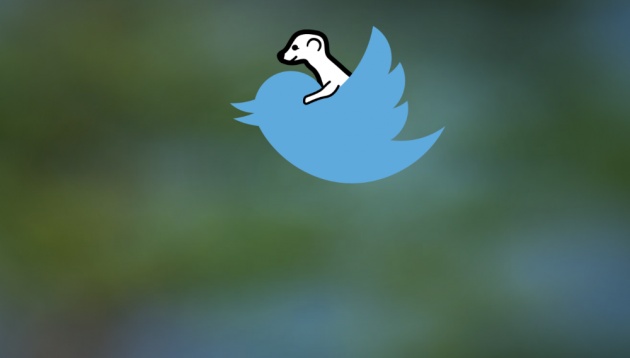
Remember that picture of the weasel riding the woodpecker?
It came to mind several times this weekend as I roamed the SXSW festival in Austin. Live streaming app Meerkat dominated the conversation at most gatherings, with the competing video streaming product, Periscope, coming up far less frequently – if at all. Then on Friday night Twitter confirmed rumors that it had closed on the acquisition of Periscope, a direct Meerkat competitor.
On the same day came the news that Twitter was shutting down some of Meerkat’s social graph access. This would make it impossible for new Meerkat users to instantly follow their Twitter network on Meerkat, hobbling the newborn app’s ability to grow.
A Twitter spokesperson said this about it:
We are limiting their access to Twitter’s social graph, consistent with our internal policy. Their users will still be able to distribute videos on Twitter and login with their Twitter credentials.
Back to the weasel and the woodpecker. It looks like a fun woodland adventure for two fuzzy friends, but the truth is a bit more bleak.
The image, which many mistook for an adorable interaction, depicts a rodent attacking a bird, the bird flying away to defend itself, and the rodent simply hanging on until it could sever a vein. The two parted ways unharmed, according to the photographer.
Meerkat’s launch in February was an unexpected rodent attack, from Twitter’s perspective. The company had already closed on an acquisition in January that would enable this exact feature on its massive platform, controlled wholly by Twitter itself. And then that damn Meerkat came along, just in time to make a splash at SXSW. To add insult to injury it was Twitter that wrote the “launch that Meerkat cribbed.at CEO Ben Rubin says that the company quickly passed the 100K user mark at SXSW and that 20 percent of Meerkat users are watching approximately two hours of video every day on the service. Eight percent of users watched three hours or more of video each day, according to IBT.
Rubin also told us today that the app now has 110K users on mobile and another 50K on the web, for a total of 160K users in less than a month.
The counterattack came on the night of the NYT Magazine party. Twitter announced the purchase of Periscope and the news came of them hatcheting Meerkat’s social graph access. Whether Twitter realized it or not, it carried Meerkat on its back on its flight path through the hype cycle. Each mention of Periscope included a mention of Meerkat, whether in news stories or in real-life discussion.
Without a Periscope app to download (the app is in limited beta right now), some folks even turned to Meerkat to discuss Twitter’s moves.
Every startup founder that gains opposition in the form of a larger company with better resources says that the move ‘validates their space’. In this case, especially in the absence of a launched product, it probably did. Not only did Twitter plan to move into the live broadcasting arena, but it was removing social graph access and giving the Meerkat team only two hours notice, according to reports. The perception of Meerkat as an early threat to Twitter’s new streaming product gave it a sense of buzz.
Not every SXSW darling graduates from the high school prom a successful adult, as JP Mangalindan eloquently puts it in this piece. Foursquare and Twitter were two legitimate SXSW sweethearts, going on to become relatively healthy businesses, compared to Highlight (an app that blew up at SXSW 2012 that you’ve likely already forgotten).
But when Twitter both announces a competitor and signals that the competitor could have been a threat on a stage as grand as SXSW, it only offers Meerkat a free ride up in the clouds. Just like that weasel.
“We really feel humbled and excited and we just want to give back as much as we’re getting from our users,” said Rubin in a phone conversation with TechCrunch today. “We’re so happy for the space. Twitter is a great company and they’re buying in, which makes them a smart company, too. We’re sure they’ll do something very nice but our approach is different and we have different views on what the product should be. It doesn’t mean one product is better than the other, it just means that we’re both excited about live video, and I’m glad we share that.
A similar strategy played out between Instagram (Facebook) and Twitter in late 2012/early 2013. Instagram not only turned off Twitter Cards integration, forcing Twitter users to Instagram.com when they clicked on Insta links, but they also announced Instagram Video in reaction to Twitter’s video-sharing platform, Vine. In the end, Vine survived, and got quite a bit of attention alongside the launch of Instagram Video.
Meerkat founder Ben Rubin is well aware of the fact that Meerkat can’t be fully reliant on any one platform. He mentioned that Facebook isn’t necessarily a good fit, given that content shared on Facebook usually isn’t seen by other users in real-time, as it is on Twitter.
But 100k users were already signed up before Twitter shut off social graph integration, meaning that their network was already populated with users they follow on Twitter. Should Meerkat move to an integration with the phone’s contact book, the way that Snapchat has been operating and growing for years now, there is no reason why the new livestreaming app can’t have its own self-sustained network that uses its own push notifications.
Twitter was for early growth, not long-term sustainability.
Twitter’s purchase of Periscope, alongside its defensive media strategy during SXSW, is a bet on live broadcasting as a medium for social sharing online. It’s not a new idea – Twitch and Justin.tv are the dinosaurs in the space – but it’s only just now begun to make sense thanks to advancements in mobile technology. And if Twitter’s betting on live broadcasting becoming a real thing, then it’s very possible Meerkat and Twitter will continue on just like the weasel and the woodpecker. Both will exit the altercation unharmed, venturing down their separate but parallel paths.



